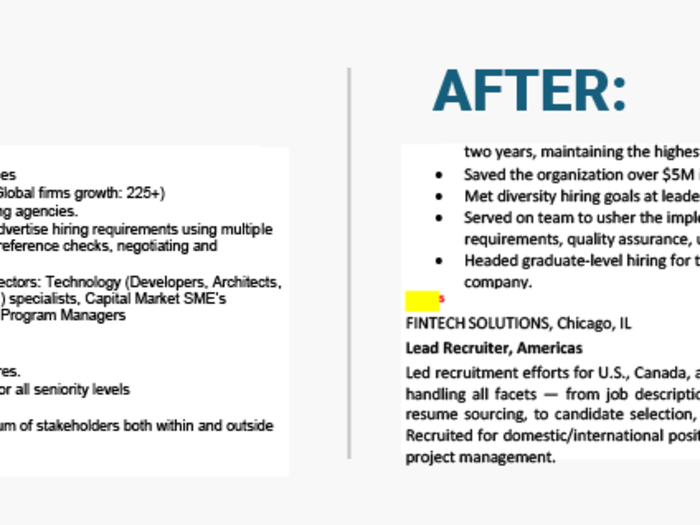
Doing this reduces obvious gaps between roles.
Once Dan removed the months from Lewis' dates of employment, the one-month contract with Lighting Solutions Manufacturer was no longer needed to fill a perceived gap in his employment, Augustine says.

"At this point in Lewis' career, it isn't necessary to add a bunch of details from an unrelated role he held nearly 13 years ago," Augustine says.
To avoid calling attention to a small gap in employment and to save space, Dan omitted the details from Lewis' first job out of college and his short-lived relocation to Colorado. He replaced this information with a Career Note that briefly mentions this earlier experience without going into too much detail.
"This technique is also useful if you've been working for more than 15 years and need to eliminate some of your earlier experiences without divulging dates," Augustine says.

"Recruiters want to know more than a description of your role at a company; they want to know what you've been able to accomplish or how you've contributed to the team's success by serving in your role," Augustine says.
To highlight the results Lewis was able to produce in each role he's held, Dan created a Key Contributions section that listed, in bullet form, highlights of Lewis' measurable success.
Whenever possible, Dan included numbers to quantify the results Lewis produced for his employers.
Dan drew the reader's attention to these highlights by turning the first portion of each job description into a paragraph and then only using bullets to call out Lewis' key contributions, Augustine says.

Dan removed Lewis' one-month contract between jobs.
"Even though this work experience is relevant to Lewis' goals, it wasn't necessary to include such a short stint on his résumé," Augustine says.

Lewis hadn't updated his résumé since he was hired at his current job in 2015, something Augustine says she sees at Topresume quite frequently.
To help Lewis brainstorm his responsibilities and key contributions, Dan asked Lewis to fill out a portion of Topresume's free résumé worksheet for his current role.
Augustine says that, since the work Lewis has been able to accomplish at this job is impressive and relevant to his immediate job goals, Dan made sure to dedicate a good chunk of space to highlight his responsibilities there and the results he's accomplished in less than three years.
"Employers expect you to provide more information about your most recent job on your résumé than some of your older, less relevant roles, assuming your recent experience ties back to your current job goals and you've been at the job for at least a few years," Augustine says.

Augustine says that many employers use software known as an applicant tracking system to filter job applications and determine which ones are most likely to be a good fit for their role.
As a result, she says it's important to include relevant keywords that are found within the job description to help your application make it past this initial gatekeeper.
Dan incorporated a selection of appropriate keywords into the top third of Lewis' résumé by adding a key skills section.
This section is also referred to as a core competencies or areas of expertise section on the résumé, Augustine says.

Your professional summary— the first section at the top of your résumé, below your contact information — is an important ways for you to demonstrate your value to prospective employers.
Dan expanded Lewis' professional summary to highlight Lewis' qualifications for the role he's targeting. "In other words, Dan fleshed out his elevator pitch," Augustine says.
According to Augustine, a good résumé professional summary should incorporate your level of experience, most relevant achievements, the industry(s) in which you've worked, assuming they're relevant to your current job search, and your job goals.

Lewis already had a LinkedIn profile, but he hadn't added this information to his résumé, Augustine tells Business Insider.
Dan made sure Lewis customized the public URL for his LinkedIn profile to include his name before adding it to his new résumé.
He also encouraged Lewis to edit the information on his LinkedIn profile to match his updated résumé document.
"In today's high-tech job market, most recruiters will search online for a candidate to see if his résumé and online profiles are consistent, so make sure both resources tell a consistent story about your experience and goals," Augustine says.
 Love in the time of elections: Do politics spice up or spoil dating in India?
Love in the time of elections: Do politics spice up or spoil dating in India?
 Samsung Galaxy S24 Plus review – the best smartphone in the S24 lineup
Samsung Galaxy S24 Plus review – the best smartphone in the S24 lineup
 Household savings dip over Rs 9 lakh cr in 3 years to Rs 14.16 lakh cr in 2022-23
Household savings dip over Rs 9 lakh cr in 3 years to Rs 14.16 lakh cr in 2022-23

Copyright © 2024. Times Internet Limited. All rights reserved.For reprint rights. Times Syndication Service.